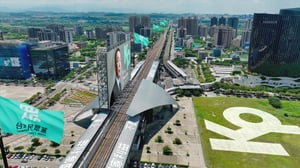This year sees one of the largest-ever election cycles with over 50 countries and more than 2 billion voters heading to the polls. These events are a critical time for news broadcasters where the ability to convey complex data clearly and engagingly can make all the difference. Pixotope has revolutionized this aspect of broadcasting, providing a dynamic and visually compelling way to present election results. By seamlessly integrating augmented reality (AR) into live broadcasts alongside TTL (Through The Lens) tracking from drones, Pixotope allows broadcasters to present data in a way that is not only informative but also captivating for viewers.
How Pixotope Revolutionizes Election Coverage with AR Graphics
Pixotope graphics transform traditional election coverage by adding a layer of interactive and immersive visuals. Instead of static charts and numbers, broadcasters can use AR to create 3D graphics that float in the studio or appear to interact with the physical environment. This technology enables presenters to walk around and interact with the graphics, offering a more engaging narrative as they explain complex electoral data.
During an election broadcast, Pixotope can create a virtual map of the country showing live results data as they come in. Presenters can zoom into specific states or districts, highlight key battleground areas, and display detailed voting statistics, all in real-time. This interactivity helps viewers understand the election dynamics more intuitively and keeps them glued to the screen.
Thai broadcaster Amarin TV utilized Pixotope Graphics in their election coverage to enhance storytelling
For example, South Korean broadcaster KBS covered the 2022 Presidential Election by deploying a large, curved LED volume and three Pixotope XR software engines. Having previously used Pixotope’s extended reality technology, KBS saw the potential to expand its physical set with a reproduction of the presidential residence, the Blue House, complemented with high-quality graphics. An additional outdoor set was enhanced with XR-generated stars and streetlights, creating highly engaging, yet realistic scenes. Underscoring their success, their broadcast was the most watched on election night.
The ability to visualize data in such an innovative way also means that broadcasters can better illustrate trends and predictions. For example, Pixotope can animate graphs showing voter turnout over time or simulate different scenarios based on current voting patterns. These graphics make abstract data concrete and digestible, enhancing viewers' overall comprehension of the electoral process.
“We were keen to move to technology that was based on the Unreal game engine for the quality and performance it offers. We found that Pixotope made the perfect bridge between the needs of live broadcasters, like us, and the abilities of ‘Unreal’. Our aim was to use this new technology within a newsroom setting to achieve a more genuine feel, whilst still using engaging visuals. As the election is a serious topic, it was imperative that our coverage adhered to a real-world tone. We wanted to avoid using a green screen studio as we felt this would appear to distance the presenter from reality.”
Lionel Barbier, Editorial Technical Manager from the Artistic Direction for TF1 news
Reliable tracking data is crucial for maintaining the professional quality of the broadcast, as even slight misalignments can break the illusion of augmented reality, distracting viewers and undermining the presentation's credibility. This is where Pixotope Fly proved its resilience earlier this year.
Pixotope Fly: Rock Steady Tracking in Extreme Conditions
In January this year, Pixotope Fly, the company’s Through The Lens (TTL) camera tracking solution was used in one of the most extreme and challenging set of conditions outside of a war zone during the Iowa Caucus event in Des Moines, Iowa.
A major winter storm swept through the Midwest of America. In addition to the heavy snow and icy conditions, the air temperatures plummeted well below zero with wind chill bringing temperatures down to -27 C (-16.6 F).
The production team was severely delayed due to airline cancellations, but everybody made it to the site in time for setup. Working in a site cabin next to the river, keeping warm was the team's priority, they even had to battle to keep the power on as the diesel fuel started to freeze. It was all hands on deck to get the drone up in the air, tracked and the graphics on air.
The possibility of this severe weather event had already been discussed in pre-planning in November between Pixotope and the broadcaster. Reviewing the live drone footage and with some on-site mastery of Unreal Engine, the graphics were transformed to reflect the dramatic wintry scene with extra ice textures, diffuse reflections and broken ice objects.
Despite the harsh weather, the expert drone pilot launched the drone, controlled from their car and the video output was sent to the remote cabin where Pixotope did the real-time tracking and playout of the graphics including live data. Pixotope Fly tracking remained rock steady, delivering seamless and stable tracking data that ensured the AR graphics were perfectly aligned with the live footage.
The success of Pixotope Fly in such conditions underscores the technology's versatility and reliability. Broadcasters can confidently use it in various outdoor environments. This flexibility opens up new possibilities for creative and engaging election coverage, allowing broadcasters to bring the excitement and drama of election night to viewers, no matter where the action unfolds.
Real-time graphics and tracking from Pixotope are game-changers for election coverage, providing broadcasters with powerful tools to enhance their storytelling. The immersive and interactive nature of AR graphics helps demystify complex electoral data, making it more accessible and engaging for viewers and providing sponsorship opportunities, from more remote locations not previously possible.
As the adoption of real-time technologies continues, we can expect even more innovative uses of AR in broadcasting, like we have seen in sports, further transforming how we experience and understand significant events like elections. Pixotope's advancements are at the forefront of this transformation, setting new standards for election coverage and beyond.

Our colleagues Volker and Emilio who were providing on-site support for the broadcaster.


COMMENTS